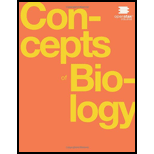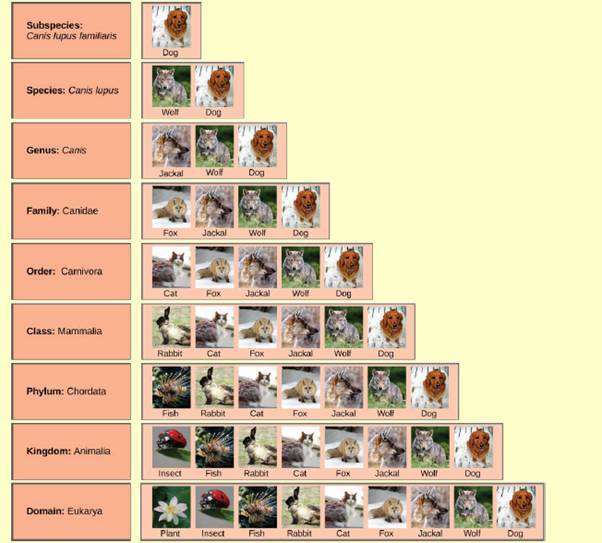
Concept explainers
Figure 12.3 In what levels are cats and dogs considered to be part of the same group?


To determine:
The levels in which the cats and dogs are considered to be the part of same group.
Introduction:
The hierarchical system classifies the various species into the groups. Such system is also termed as the taxonomic classification, as each level as termed taxa here. Broadly the organism is classified in kingdom and domain. The genus and the species name are the most accurate classification.
Explanation of Solution
The scientific name of the cat is Felis catus which belongs to the family Felidae. They are domestic cats. The classification of the cat is as below:
Kingdom − Animalia (It is composed of multicellular eukaryotic animals.)
Phylum − Chordata (The organisms that contain notochord, dorsal nerve cord, pharyngeal slits, an endostyle, and a post-anal tail during any period of their life cycle.)
Class − Mammalia (The vertebrate animals compose this class.)
Order − Carnivora (It is composed of meat-eating animals.)
Suborder − Feliformia (It contains the cat-like carnivores.)
Family − Felidae (This family mainly consists of cats only.)
Subfamily − Felinae (This subfamily is comprised of small cats. These cats do not roar but are able to purr.)
The scientific name of the dog is Canis lupus familiaris. It is basically the domestic dog. The scientific classification of the dog is as follow:
Kingdom − Animalia
Phylum − Chordata
Class − Mammalia
Order − Carnivora
Family − Canidae (This family consists of domestic dogs, wolves, coyotes, foxes, jackals, and others.)
The cats and the dogs belong to the kingdom Animalia, phylum Chordata, class Mammalia, and order Carnivora. This means that both dogs and cats are multicellular animals, that contained notochord and other differential structures during their lifetime. Moreover, they are vertebrate and are carnivorous animals.
The cats and the dogs are similar at the levels of kingdom, phylum, class, and order.
Want to see more full solutions like this?
Chapter 12 Solutions
Concepts of Biology
Additional Science Textbook Solutions
College Physics
Biology: Life on Earth
Campbell Biology (11th Edition)
Biological Science
Campbell Essential Biology (7th Edition)
Human Biology: Concepts and Current Issues
- Dolphins and fish have similar body shapes. Is this feature more likely a homologous or analogous trait?arrow_forwardThe scientific name for the African rock python is Python sebae. Which name indicates its genus?arrow_forwardCompare and contrast Old and New World monkeys, what do they have in common? How do they vary? How does your text specify New World monkeys migrated from Africa?arrow_forward
- Which group of mammals have live birth but lack a placenta? Group of answer choices Metatheria Eutheria Prototheria Primatesarrow_forwardHow is that diversity important to the ecosystem? ( Diversity in animals)arrow_forwardCreate a dichotomous key between housefly, hard tick, and sheep ked using morphological characteristics. Housefly: 6 legs, 3 body parts, black, wings, hair Hard tick: 8 legs, 2 body parts, brown, no wings, no hair Sheep ked: 6 legs, 3 body parts, brown, no wings, hairarrow_forward
- At what level of organization do humans and zebra mussels diverge? Question 1 options: Phylum Kingdom Domain Classarrow_forwardWhich of the following is NOT a way that primates can occupy different niches? A. By being nocturnal or diurnal B. By living in the same territory C. By eating different types of food D. By living in the trees or on the groundarrow_forwardUse the labels to complete the new connections in the concept map, which explain how animals originated in diversified. each doc may receive multiple labels. Drag and drop each correct label to each doc. Not all labels will be used.arrow_forward
- Which classification group do we share it with all primates? A. Genus B. Class C. Order D. Family arrow_forwardWhich of the following organisms is most closely related to whales?arrow_forwardUsing the cladogram below, answer the following question. The wolf, leopard, and domestic cat are all mammals that are meat-eaters with four legs and claws. Why is the wolf not classified with the leopard and domestic cat? a Wolves do not have retractable claws. b Wolves howl and do not purr. c Leopards and domestic cats have fur, while wolves do not. d Wolves are technically not mammals.arrow_forward
 Concepts of BiologyBiologyISBN:9781938168116Author:Samantha Fowler, Rebecca Roush, James WisePublisher:OpenStax College
Concepts of BiologyBiologyISBN:9781938168116Author:Samantha Fowler, Rebecca Roush, James WisePublisher:OpenStax College Biology 2eBiologyISBN:9781947172517Author:Matthew Douglas, Jung Choi, Mary Ann ClarkPublisher:OpenStax
Biology 2eBiologyISBN:9781947172517Author:Matthew Douglas, Jung Choi, Mary Ann ClarkPublisher:OpenStax Biology (MindTap Course List)BiologyISBN:9781337392938Author:Eldra Solomon, Charles Martin, Diana W. Martin, Linda R. BergPublisher:Cengage Learning
Biology (MindTap Course List)BiologyISBN:9781337392938Author:Eldra Solomon, Charles Martin, Diana W. Martin, Linda R. BergPublisher:Cengage Learning



